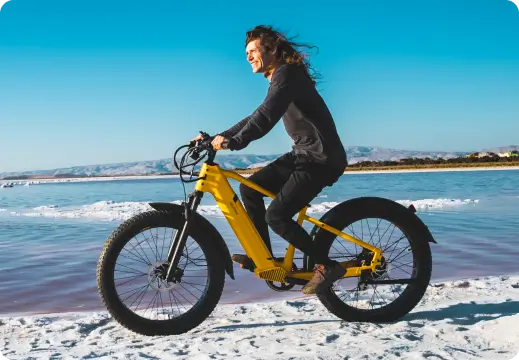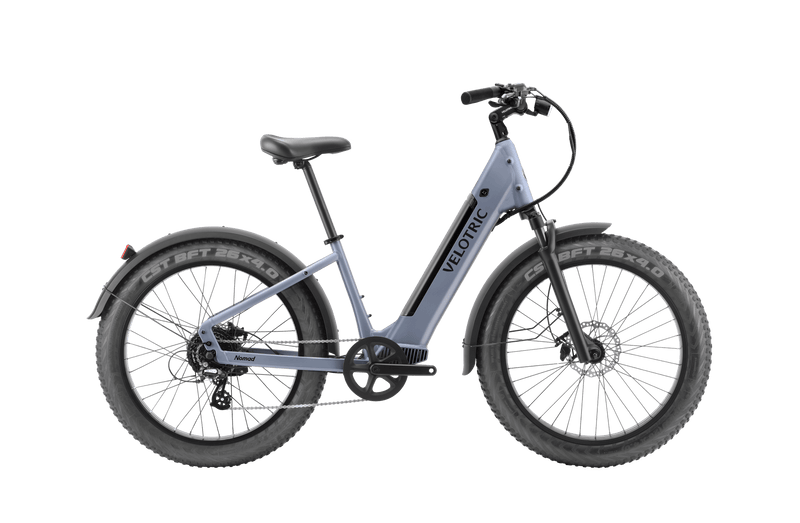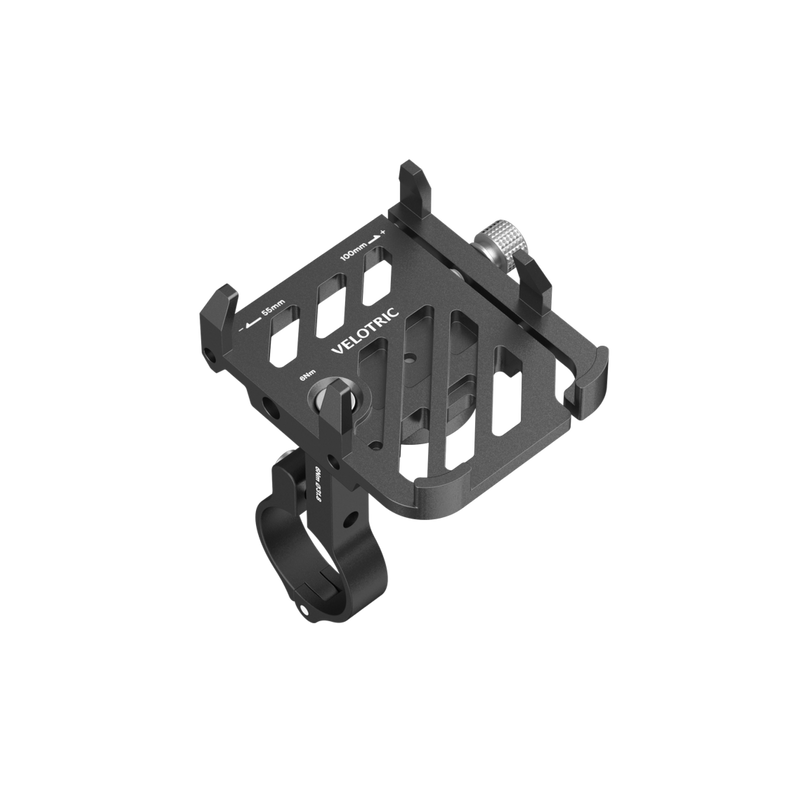If you're thinking of swapping your car for an electric bicycle, you aren't alone. E-bikes are gaining popularity. In 2021, more electric bicycles were sold than electric cars in the United States.
It's easy to get the hype. E-bikes have a lot of advantages over cars (especially traditional cars), like being less expensive and easier to maintain.
That said, e-bikes aren't perfect for every occasion. Sometimes, you'll want a car to get the job done.
Below, we’ll explain when it makes sense to use each type of vehicle and provide pointers to help you determine whether an e-bike or a car is right for you.
When does it make sense to use a car?
Riding on two wheels has its benefits. But sometimes, a good old-fashioned four-wheel car is the best way to get from point A to point B.
Here are some instances when you'll probably prefer an automobile to an electric bicycle:
- Traveling long distances. While long-range e-bikes go up to about 138 miles on one charge, the average e-bike won't make it more than 55 to 65 miles. You can travel farther in a car, and riding in a car (with perks like air conditioning and a seat back to lean against) can be more comfortable. For long rides, make it a car trip.
- Hauling lots of goods. E-bikes can carry some loads. For example, a bike rack can hold a bag or two. It's also possible to hitch a trailer to an e-bike to carry more. However, you won't beat the capacity of a car trunk. A car is more practical when transporting lots of goods (like the weekly grocery run).
- Riding in poor weather. A great thing about e-bikes is that they let you get out into the open air; you aren't constrained by the structure of a car. However, that freedom is less fun when it's raining or snowing. Cars may also be safer when conditions are treacherous. For example, it's easier to navigate icy roads on four wheels (more wheels = more traction) than on two.
- Transporting multiple people. Preparing to transport the kids to school? Planning a road trip with friends? Headed to the beach with the whole family? Whenever you're trying to move multiple people, a car is the easier option. A bike is great if there's just one passenger — you!
When does it make sense to use an e-bike?
While cars certainly have their advantages, they aren't always the preferable vehicle. If you aren't dealing with any of the scenarios listed above, you might want to try an e-bike.
Here are some of the perks of riding on two wheels:
- Skip the parking hassle. Finding parking can be a pain when you're in a car, especially in a city with limited spots. In contrast, an electric bike doesn't require a big parking space. If you want, you can even carry it inside your home or office. (Hint: Foldableelectric bikes are perfect for easy carrying).
- Avoid traffic and get there faster. While cars can reach higher speeds, they're more likely to get stuck in city traffic. An e-bike can be a big perk in a city, where you can use shoulder bike lanes to avoid traffic congestion. Depending on the class of e-bike, you may also be able to use traditional bike paths. (This guide to e-bike motors has more details on e-bike classes and what each class permits).
- Save money on fuel and maintenance costs. An electric vehicle doesn't require gasoline. This means that e-bikes can save you significantly on fuel costs. E-bikes are also lower maintenance than cars. We'll get into more detail on the cost savings in the next section.
- Get some exercise. If you want to add more physical activity to your life, an e-bike is the answer. E-bikes offer cardiovascular health benefits and help build leg muscles. You can control how strenuous your workout is by adjusting the motor-powered pedal assist system (PAS), which helps move the bike forward while you pedal. Learn how to get a good e-bike workout.
- Help the planet. Since e-bikes don't burn fossil fuels, they don't release harmful carbon emissions into the environment. This makes e-bikes good for the environment and can help combat climate change. Plus, e-bikes are relatively quiet and don't contribute to noise pollution, which can be an issue in large cities.
Cost comparison: e-bikes vs. cars
We're not saying it's ALL about the money — but finances are a big factor when selecting your preferred mode of transport. E-bikes win big on this point.
Here's a breakdown of the basic costs you can expect for a car versus an e-bike (don't worry, we've summarized all of these details in one simple car vs. e-bike cost table at the end)!
First, let's talk about the initial purchase cost.
A new e-bike runs from $1,200 to $2,000 (for a basic commuter bike). A high-end customized e-bike might go up to $12,000. In contrast, the average used car in the United States costs $33,341. A new car typically costs even more.
Next, you must consider fuel or power costs. The e-bike motor is powered by a rechargeable battery, so there are no fuel costs. However, you have to factor in the added electric costs. You can calculate this with the formula:
(Battery capacity in kWh x 1.25) x cost of electricity per kWh
Let's look at Velotric's Discover 1 e-bikes, which come with a 500Wh battery. Let's also assume an electricity price of $0.166 per kWh (based on this U.S. data). That gives us:
(0.5kWh x 1.25) x $0.166
=
(0.625) x $0.166
=
$0.10375
So, it takes about 10 cents to charge up the bike completely. (P.S.: The Discover 1 charges completely in only six hours!)
Here's what that equation looks like for the Nomad 1, which has a slightly bigger battery of 750kWh:
(0.75kWh x 1.25) x $0.166
=
(0.9375) x $0.166
=
$0.1556
In this case, it will take about 16 cents to charge the bike's battery completely. Like the Discover 1, the Nomad 1's UL 2271 Recognized battery charges fully in just six hours.
Now, let's compare that to fueling a car. The average gas tank holds 13 to 16 gallons. As of December 2022, the average price of gas in the U.S. was $3.33 (national average).
For a 13-gallon tank, that means: 13 x 3.33 = $43.29
For a 16-gallon tank, that means 16 x 3.33 = $53.28
The e-bike is clearly cheaper. That said, the fully charged e-bike battery won't get you as far as a fully gassed-up car. For example, the Discover 1 has a range of 65 miles, while the Nomad 1 has a range of 55 miles.
Now, compare that to a 13-gallon car that gets 24.2 miles per gallon (the national average MPG for cars in the U.S.): According to this distance calculator, that will take you 314.6 miles. For a 16-gallon car, you'll go 387.2 miles.
Next up: maintenance. Experts estimate that e-bike maintenance costs $400 to $450 per year on parts, maintenance, and related service fees. In contrast, annual car maintenance fees can average a whopping $9,666.
Finally, whether you choose a car or a bike, you want to protect your investment — insurance is the answer. You can insure a standard e-bike for as little as $30 per month or $630 per year, while car insurance averages $1,630 annually in the U.S.
| E-bike | Car | |
| Initial cost of purchase | $1,200 to $12,000 | $33,341 |
| Fuel costs | 10 to 16 cents per full charge | $43.29 to $53.28 to fill gas tank |
| Range | 55 to 65 miles | 314 to 387 miles |
| Maintenance costs | $400 to $450 annually | $9,666 annually |
| Insurance costs | $630 annually | $1,630 annually |
Are e-bikes better than cars?
Here's the truth: We can't say if e-bikes are better or worse than cars. The fact is that the right vehicle for you depends on your unique needs.
For example, if you need to carpool the kids to school every morning or are planning a long-distance road trip, a car is the better option.
However, e-bikes work great in many contexts, such as urban driving, where they let you whizz around traffic jams and get from point A to point B faster. E-bikes also have other perks, like being eco-friendly, giving you a workout, and allowing you to avoid the hassle of city parking.
On top of it all, e-bikes are significantly more cost-effective. From the initial purchase to the subsequent maintenance, an e-bike is cheaper than a car on all fronts.
Are e-bikes safe?
E-bikes are safe and comfortable. This is partly due to the motor — which sets the e-bike apart from a standard bike.
The e-bike motor supports a pedal assist system (PAS), which helps power the bike forward while pedaling, allowing for faster speeds and start times. This makes it easier to keep up with traffic and start quickly after a red light or stop sign, for example. By keeping up with the flow, cyclists can stay safe.
A quality e-bike will also come with safety features like front and rear lights and reflectors to improve visibility. Velotric's Discover 1 and Nomad 1 bikes tick all of these boxes.
Velotric's bikes also come with other features that enhance safety, such as hydraulic disc brakes, allowing for crisp stops.
Of course, it's important to follow best practices to promote cycling safety. For example, you should always wear a helmet. (P.S. Did you know that some states require helmets by law? Here's a list of state helmet laws).
Are e-bikes good for the environment?
If you want to do your part to help protect our planet, investing in an e-bike is a good start. E-bikes don't require fossil fuels — they rely on a battery to power the motor — so they don't produce carbon emissions.
With an e-bike, you’ll reduce your carbon footprint and help protect the ozone. Pro tip: Recognizing the positive environmental impact of e-bikes, some states offer tax rebates and incentives to help people buy them. Check your state's options!
Plus, e-bikes are relatively quiet when they operate. This means that you'll also cut down on noise pollution. This can be an especially big boon for congested or noisy urban areas.
Discover the best e-bike options for you from Velotric
If you've read all the facts in the great e-bike vs. car debate and decided an e-bike is right for you, Velotric has you covered. We offer two bikes suited to two different purposes.
The Discover 1 has a range of up to 65 miles, while the Nomad 1 is a fat tire bike with a range of up to 55 miles. The Nomad 1's fat tires make it suitable for non-city riding on grass or dirt surfaces, for example.
Velotric's e-bikes come with essential features like rear and front lights, reflectors, and hydraulic disc brakes. The powerful battery charges in just six hours and is certified by Underwriters Laboratories (UL2271), a global safety standards organization.
Plus, Velotric's bikes come in two frame types: The high-step model is ideal for riders with heights of 5’6” to 6’9”, while the step-through model is ideal for riders with heights of 5’1” to 6’4”.
Test out a Velotric e-bike and find your perfect ride today.







































